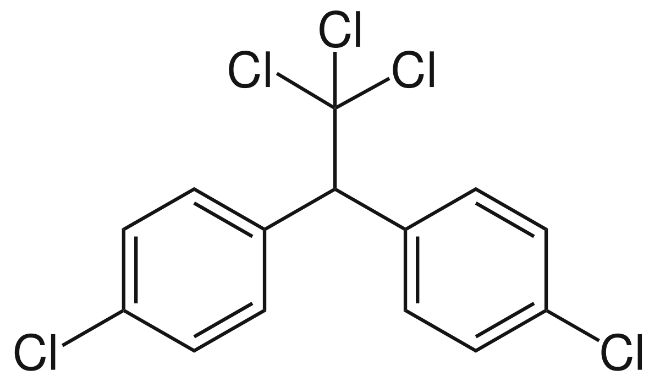
Write structure of D.D.T?
Answer
448.5k+ views
Hint:DDT stands for dichlorodiphenyltrichloroethane and it is a chemical compound with the formula \[{C_{14}}{H_9}C{l_5}\] . It is also called 1,1,1-trichloro-2,2-bis(p-chlorophenyl) ethane, and is a synthetic insecticide which belongs to the family of organic halogen compounds.
Complete answer:
DDT is a colourless, tasteless (at standard conditions for temperature and pressure, STP) and almost odourless organochlorine. DDT is very popularly known for its insecticidal properties. It has been easily formulated in almost every form which includes solutions in petroleum distillates, emulsifiable concentrates, and smoke candles.
The structure of DDT is shown below:

The molar mass of DDT corresponds to 354.48 grams per mole and under the standard conditions, the density of this compound is roughly equal to 1 gram per cubic centimetre. The melting point of this chemical compound is approximately equal to 108.5 degrees Celsius or 381.6 K and boiling point is approximately equal to 260 degrees Celsius or 533 K. DDT is very poorly soluble in water and for all practical purposes, this compound is insoluble in water. The solubility of dichlorodiphenyltrichloroethane in water corresponds to 25 micrograms per litre.
Note:
DDT is the first chlorinated organic insecticide which was prepared in 1873. The effectiveness of DDT as an insecticide was first discovered by Paul Muller of Geigy Pharmaceuticals in Switzerland. It was largely used after the Second World War to control diseases like malaria and typhus among the civilians and the troops and after the war, DDT was made available for agricultural uses and therefore when it comes to the use of DDT, it has immensely increased over time.
Complete answer:
DDT is a colourless, tasteless (at standard conditions for temperature and pressure, STP) and almost odourless organochlorine. DDT is very popularly known for its insecticidal properties. It has been easily formulated in almost every form which includes solutions in petroleum distillates, emulsifiable concentrates, and smoke candles.
The structure of DDT is shown below:

The molar mass of DDT corresponds to 354.48 grams per mole and under the standard conditions, the density of this compound is roughly equal to 1 gram per cubic centimetre. The melting point of this chemical compound is approximately equal to 108.5 degrees Celsius or 381.6 K and boiling point is approximately equal to 260 degrees Celsius or 533 K. DDT is very poorly soluble in water and for all practical purposes, this compound is insoluble in water. The solubility of dichlorodiphenyltrichloroethane in water corresponds to 25 micrograms per litre.
Note:
DDT is the first chlorinated organic insecticide which was prepared in 1873. The effectiveness of DDT as an insecticide was first discovered by Paul Muller of Geigy Pharmaceuticals in Switzerland. It was largely used after the Second World War to control diseases like malaria and typhus among the civilians and the troops and after the war, DDT was made available for agricultural uses and therefore when it comes to the use of DDT, it has immensely increased over time.
Recently Updated Pages
Using the following information to help you answer class 12 chemistry CBSE

Full Form of IASDMIPSIFSIRSPOLICE class 7 social science CBSE

In case of conflict between fundamental rights of citizens class 7 social science CBSE

Can anyone list 10 advantages and disadvantages of friction

What are the Components of Financial System?

Complete the letter given below written to your Principal class null english null

Trending doubts
Which are the Top 10 Largest Countries of the World?

Differentiate between homogeneous and heterogeneous class 12 chemistry CBSE

Draw a labelled sketch of the human eye class 12 physics CBSE

What is the Full Form of PVC, PET, HDPE, LDPE, PP and PS ?

What is a transformer Explain the principle construction class 12 physics CBSE

What are the major means of transport Explain each class 12 social science CBSE




